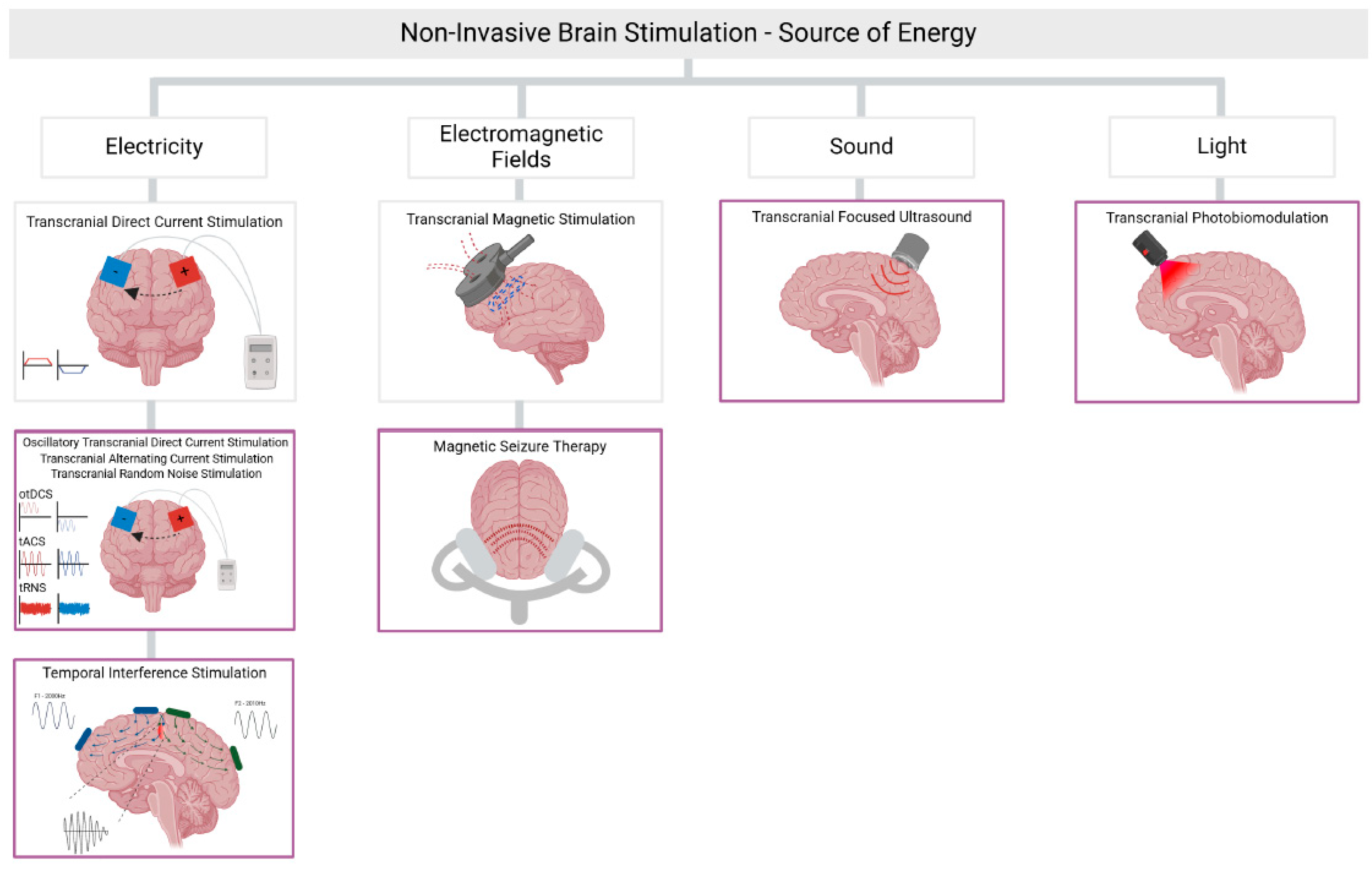Emerging Trends in Non-Invasive Brain Stimulation: The New Kids on the Block
Conflicts of Interest
References
- Lam, R.W.; Kennedy, S.H.; Adams, C.; Bahji, A.; Beaulieu, S.; Bhat, V.; Blier, P.; Blumberger, D.M.; Brietzke, E.; Chakrabarty, T.; et al. Canadian Network for Mood and Anxiety Treatments (CANMAT) 2023 Update on Clinical Guidelines for Management of Major Depressive Disorder in Adults: Réseau canadien pour les traitements de l’humeur et de l’anxiété (CANMAT) 2023: Mise à jour des lignes directrices cliniques pour la prise en charge du trouble dépressif majeur chez les adultes. Can. J. Psychiatry 2024, 69, 641–687. [Google Scholar] [PubMed]
- Brunoni, A.R.; Sampaio-Junior, B.; Moffa, A.H.; Aparício, L.V.; Gordon, P.; Klein, I.; Rios, R.M.; Razza, L.B.; Loo, C.; Padberg, F.; et al. Noninvasive brain stimulation in psychiatric disorders: A primer. Rev. Bras. Psiquiatr. 2019, 41, 70–81. [Google Scholar] [CrossRef] [PubMed]
- Iszak, K.; Gronemann, S.M.; Meyer, S.; Hunold, A.; Zschüntzsch, J.; Bähr, M.; Paulus, W.; Antal, A. Why temporal inference stimulation may fail in the human brain: A pilot research study. Biomedicines 2023, 11, 1813. [Google Scholar] [CrossRef] [PubMed]
- Zhu, Z.; Yin, L. A mini-review: Recent advancements in temporal interference stimulation in modulating brain function and behavior. Front. Hum. Neurosci. 2023, 17, 1266753. [Google Scholar] [CrossRef] [PubMed]
- Bellini, H.; Cretaz, E.; Carneiro, A.M.; da Silva, P.H.R.; dos Santos, L.A.; Gallucci-Neto, J.; Brunoni, A.R. Magnetic waves vs. Electric shocks: A non-inferiority study of magnetic seizure therapy and electroconvulsive therapy in treatment-resistant depression. Biomedicines 2023, 11, 2150. [Google Scholar] [CrossRef] [PubMed]
- Nairuz, T.; Sangwoo-Cho Lee, J.-H. Photobiomodulation therapy on brain: Pioneering an innovative approach to revolutionize cognitive dynamics. Cells 2024, 13, 966. [Google Scholar] [CrossRef] [PubMed]
- Weerasekera, A.; Coelho, D.R.A.; Ratai, E.-M.; Collins, K.A.; Puerto, A.M.H.; De Taboada, L.; Gersten, M.B.; Clancy, J.A.; Hoptman, M.J.; Irvin, M.K.; et al. Dose-dependent effects of transcranial photobiomodulation on brain temperature in patients with major depressive disorder: A spectroscopy study. Lasers Med. Sci. 2024, 39, 249. [Google Scholar] [CrossRef] [PubMed]
- Chou, T.; Deckersbach, T.; Guerin, B.; Wong, K.S.; Borron, B.M.; Kanabar, A.; Hayden, A.N.; Long, M.P.; Daneshzand, M.; Pace-Schott, E.F.; et al. Transcranial focused ultrasound of the amygdala modulates fear network activation and connectivity. Brain Stimul. 2024, 17, 312–320. [Google Scholar] [CrossRef] [PubMed]

Disclaimer/Publisher’s Note: The statements, opinions and data contained in all publications are solely those of the individual author(s) and contributor(s) and not of MDPI and/or the editor(s). MDPI and/or the editor(s) disclaim responsibility for any injury to people or property resulting from any ideas, methods, instructions or products referred to in the content. |
© 2024 by the authors. Licensee MDPI, Basel, Switzerland. This article is an open access article distributed under the terms and conditions of the Creative Commons Attribution (CC BY) license (https://creativecommons.org/licenses/by/4.0/).
Share and Cite
Brunoni, A.R.; Croarkin, P.E.; Razza, L.B. Emerging Trends in Non-Invasive Brain Stimulation: The New Kids on the Block. Biomedicines 2025, 13, 14. https://doi.org/10.3390/biomedicines13010014
Brunoni AR, Croarkin PE, Razza LB. Emerging Trends in Non-Invasive Brain Stimulation: The New Kids on the Block. Biomedicines. 2025; 13(1):14. https://doi.org/10.3390/biomedicines13010014
Chicago/Turabian StyleBrunoni, Andre R., Paul E. Croarkin, and Lais B. Razza. 2025. "Emerging Trends in Non-Invasive Brain Stimulation: The New Kids on the Block" Biomedicines 13, no. 1: 14. https://doi.org/10.3390/biomedicines13010014
APA StyleBrunoni, A. R., Croarkin, P. E., & Razza, L. B. (2025). Emerging Trends in Non-Invasive Brain Stimulation: The New Kids on the Block. Biomedicines, 13(1), 14. https://doi.org/10.3390/biomedicines13010014




